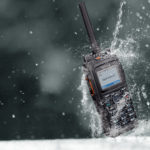
Selecting the Best Two-Way Radio for Your Job
Before you purchase any two-way radio, DO NOT TRUST THE ADVERTISING, but rely on an on-site test. Years of experience has shown that when a manufacturer claims 10,000 square feet of coverage or a 32-mile range, the very small fine print must be read or frustration will set in.
In the two-way radio industry, coverage area and ranges are based on some very special criteria. The 10,000 square feet claim is nothing but a 100 feet x 100 feet structure and it is, most likely, empty. A 0.5 watt, AA battery powered radio might work, but if the structure is full or has divisions, or it is a high rise building or factory, there is doubt that the radios will work further than a couple hundred yards. The same goes for a 32-mile range claim. Sure, if you are on top of a 3,000 feet mountain and the other user is on a roof top or in a dessert valley below, the radio might work.
There are reasons why two-way radio manufacturers offer many varieties of two way radios. Here are some pointers for selecting the best-way radio for your job:
1. Determine what area you want covered.
The power rating of the two-way radio will determine how far its signal will reach. There are radios with 0.5W to 5W of rated power. The higher the power, the bigger the coverage area.
2. Decide how rugged you need the two-way radio to be.
Two-way radios come in many shapes and sizes. They are also built with an all plastic design, plastic outside and aluminum inside or aluminum outside and inside. Each design style will provide different shock and impact protection to the components inside. The two-way radio build quality will reflect on how long the radio will last and perform at peak efficiency.
3. Decide if you want a two-way radio with a display or not.
A display provides important information on how the channel is programmed. It allows the user to assess the channel’s power rating (High or Low), Mode (Direct or Repeater), ID (which group is assigned to the channel), Battery level, and how well or not it is receiving a signal from other radios (signal strength meter). Non Display radios offer none of those benefits.
4. Determine which battery to use.
Today’s two-way radios are offered with a basic battery and a higher capacity battery. Consider how long the two-way radio will operate with each type of battery before selecting one or the other. If you need the radio to work for a full 8-hour shift and the basic battery offers 6 hours of talk time, you will need to use the higher power battery or you will be forced to purchase a second battery in order to cover the shift.
5. Consider the IP (Ingress Protection) rating.
The higher the number, the more protection the two-way radio is designed to offer its internal components against the outside elements. If you are going to use your two-way radio outdoors and in all weather conditions, don’t purchase a two-way radio that will not allow for water splashes. Believe it or not, most Police and Fire Department two-way radios are not IP67 rated. There is a chart that explains what each rating means as it relates to the two-way radio protection. It can be found at: http://www.mpl.ch/info/IPratings.html
6. Select between the standard two-way radio antenna and the short version known as Stubby.
The two-way radio antenna is used by the two-way radio to allow the power to go out to other two-way radios and the signal from other two-way radios to come in. Determining to use the long or short version depends on two variables:
a) How well the two-way radios cover your work area.
b) How much comfort does the user want when wearing the two-way radio.
The Full size antenna will receive a weak signal better than the stubby one. The stubby antenna will offer more comfort when worn on the belt. Once you know how the two-way radio will cover your work area, you will then be able to decide which antenna you will wish to use on a daily basis.
7. Channel capacity.
Two-way radios are sold with varying channel capacities. From the very basic 1 channel radio to the more sophisticated 2000 channel radio. Two-way radio channels are used to group people or groups of people into simple to identify locations. Determine how many groups your company will need to have before choosing a two-way radio. If you have 4 groups but only purchase a 2 channel radio, a decision is going to have to be made as to who uses which channel. If you decide that management will use channel 1, the three remaining groups will have to listen to each other all day long. This will generate resentment, confusion and reduce productivity.
8. Choose the right size.
Two-way radios come in all sizes. You can choose pocket size to almost 9 inches long in a full size radio. The size of the two-way radio is not a reflection of the abilities of such. Many manufacturers will offer a full size and a small size of the same radio. This means that the only thing you are giving up is the weight on the belt and the physical size in your hand. Others will offer multiple sized radios. Each will have a different IP rating or feature set. Ask about each model and its capabilities. Purchase the one that meets your needs.
Still Can’t decide? Let Metrotalk help. We start by listening to your present and future needs. We will recommend the most appropriate radio, that will have the features and future capabilities that you request. Then, we’ll deliver the same radio for you to test in your environment. If you like the way it feels, and covers your work area, we will provide the sales and FCC licensing support to guarantee your decision will work now and in the future.
